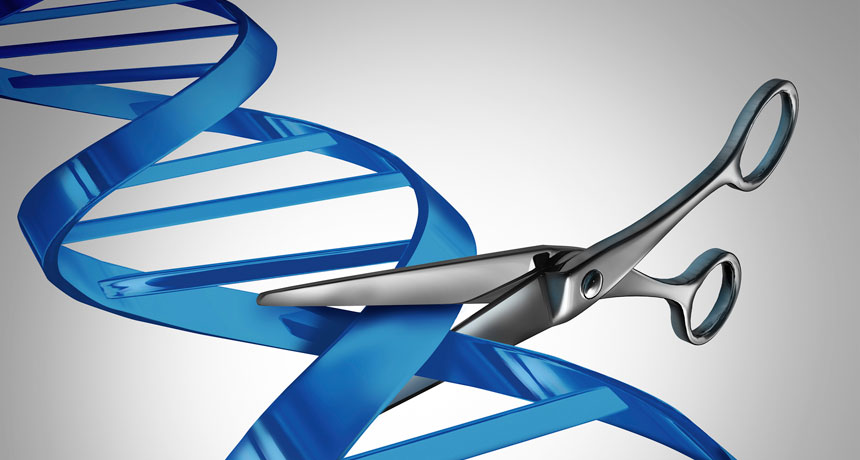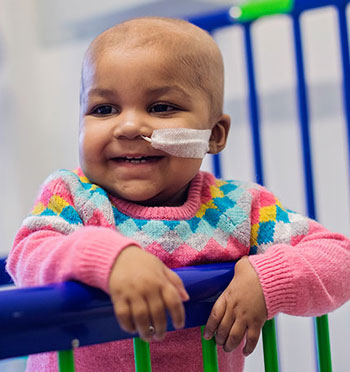Expert panel approves human gene editing
It also identified one big exception: No putting edited cells in the womb to make a baby

Researchers are using enzymes to work like scissors so that they can slice and splice sections of DNA as they edit out unwanted segments and patch in substitutes. A new expert panel says research on human gene editing should proceed, with one notable exception.
wildpixel/ iStockphoto
WASHINGTON, D.C. — Recently, scientists have been using chemical “scissors” to edit, or change, the DNA in living organisms. This swapping out of parts of DNA could replace faulty genes. In theory, it also might make it possible to create designer babies that are smarter or better-looking than other individuals. But some people have questioned whether such tinkering with human cells would be like playing god. Many people also worry that editing isn’t safe.
Those and other concerns have led some people to wonder if gene editing is so unethical that it should be banned. To answer that, a host of experts met in Washington, D.C., this week. After reviewing the science and other issues, they offered a temporary green light. On December 3, they said that research on human gene editing is needed and so should proceed.
But the experts also gave one big exception. Any cells edited in a lab may not be used to establish a pregnancy, they said. In other words, no designer babies! That also would mean researchers could not fix genetic diseases before a baby was born.
In recent years, scientists have devised increasingly precise chemical tools for cutting and pasting DNA. One recent result: Scientists created beagles with extra muscle. In that case, the researchers used “scissors” known as CRISPR/Cas9.
Such gene-editing tools have become so cheap and easy to use that it might be possible to use them soon to cure genetic diseases. But some people think the technology also could be misused, either accidently or on purpose.
The recommendations made at the end of this week’s summit came from a 12-person committee. It had organized the meeting. These experts made it clear that any concerns they have are mostly about editing genes that would be passed on to future generations. This type of editing is called germline editing.
‘Somatic’ editing? No problem
Those experts had no problem with a different type of editing, known as somatic cell editing. Somatic cells are all of those making up the body except the germ cells. Those are the egg and sperm cells that carry on genetic information to the next generation. Germ cells also include cells that will become eggs or sperm and fertilized eggs or embryos made from combining eggs and sperm.
Trials are already underway to edit somatic cells of people. So far, all editing has taken place outside the body. Altered cells are then used to treat a patient.

Earlier this week, a company called Sangamo BioSciences announced that human trials could begin next year using gene editing to replace a broken gene in hemophiliacs (HE-moh-FEE-lee-aks). These people have inherited an inability to make their blood clot. As such, even a simple cut could cause a life-threatening loss of blood without immediate medical treatment. In the trial, researchers would use a different type of molecular scissors called zinc finger nucleases. If those trials go ahead, it will be first the time gene editing takes place inside someone’s body.
The summit’s organizing committee said this week that such research on somatic cells could continue. It approved such research because it only affects one person. Changes made in that person, such as fixing a broken gene, could not be passed on to his or her children and grandchildren. Even those studies must, however, abide by existing rules for gene therapies.
Baby editing? Not yet
The gene-editing committee said that moral, ethical and safety concerns would make it “irresponsible” to proceed with human studies in germline cells. Changing these cells would transmit the edits on to future generations. Still, that doesn’t mean all germ-cell editing would be off-limits. Researchers could still edit embryos or other germ cells in labs.
As long as those cells are not implanted into a woman to create a baby, it is not germline editing, said committee chairman David Baltimore. This 1975 Nobel Prize winner is a scientist at the California Institute of Technology in Pasadena.
The scientists did not call their statement a ban on germline edits. Instead, they recommended that experts should regularly review guidelines on what and how to proceed. Science is always advancing. Public opinions can change. So at some later date there may be good reason to change policies on the editing of cells that could develop into a baby.
The new expert panel’s recommendations are not legally binding. Still, their opinions should pressure others in the field to not to defy them. For instance, researchers who don’t follow the guidelines might not be able to get their work published. Or funding agencies might refuse to give these researchers money. Scientists also must still follow their own countries’ laws and rules for working with embryos. In the United States, for instance, such work is not banned. Researchers are not, however, able to use government funds to do it.
The groups that sponsored the Washington gene-editing summit have commissioned a new study. The study’s authors are expected to report back by the end of 2016 on whether to recommend giving a green light to germline editing.
Power Words
(for more about Power Words, click here)
Cas9 An enzyme that geneticists are now using to help edit genes. It can cut through DNA, allowing it to fix broken genes, splice in new ones or disable certain genes. Cas9 is shepherded to the place it is supposed to make cuts by CRISPRs, a type of genetic guides. The Cas9 enzyme came from bacteria. When viruses invade a bacterium, this enzyme can chop up the germ’s DNA, making it harmless.
cell The smallest structural and functional unit of an organism. Typically too small to see with the naked eye, it consists of watery fluid surrounded by a membrane or wall. Animals are made of anywhere from thousands to trillions of cells, depending on their size.
CRISPR An abbreviation — pronounced crisper — for the term “clustered regularly interspaced short palindromic repeats.” These are pieces of RNA, an information-carrying molecule. They are copied from the genetic material of viruses that infect bacteria. When a bacterium encounters a virus that it was previously exposed to, it produces an RNA copy of the CRISPR that contains that virus’ genetic information. The RNA then guides an enzyme, called Cas9, to cut up the virus and make it harmless. Scientists are now building their own versions of CRISPR RNAs. These lab-made RNAs guide the enzyme to cut specific genes in other organisms. Scientists use them, like a genetic scissors, to edit — or alter — specific genes so that they can then study how the gene works, repair damage to broken genes, insert new genes or disable harmful ones.
embryo The early stages of a developing vertebrate, or animal with a backbone, consisting only one or a or a few cells. As an adjective, the term would be embryonic — and could be used to refer to the early stages or life of a system or technology.
enzymes Molecules made by living things to speed up chemical reactions.
ethics (adj. ethical) A code of conduct for how people interact with others and their environment. To be ethical, people should treat others fairly, avoid cheating or dishonesty in any form and avoid taking or using more than their fair share of resources (which means, to avoid greed). Ethical behavior also would not put others at risk without alerting people to the dangers beforehand and having them choose to accept the potential risks.
gene A segment of DNA that codes, or holds instructions, for producing a protein. Offspring inherit genes from their parents. Genes influence how an organism looks and behaves.
genetic Having to do with chromosomes, DNA and the genes contained within DNA. The field of science dealing with these biological instructions is known as genetics. People who work in this field are geneticists.
germline The egg cells and sperm cells that organisms use pass along their genes to the next generation. Egg and sperm cells are called germ cells. Germ cells also include cells that will become eggs or sperm and fertilized eggs or embryos made from combining eggs and sperm. (All other cells of the body are known as somatic cells.)
hemophilia A group of genetic disorders in which blood does not clot effectively after a cut. Affected people can suffer excessive blood loss after a simple cut or bruise. The gene for this disease is carried on the X chromosome. Because men have only one X chromosome, those with the gene for this disorder will always develop it. Women have two X chromosomes, so they only develop hemophilia if they inherit the gene from both parents.
immune Able to ward off a particular infection. Alternatively, this term can mean to show no impacts from a particular poison or process. More generally, the term may signal that something cannot be hurt by a particular drug, disease or chemical.
leukemia A type of cancer in which the bone marrow makes high numbers of immature or abnormal white blood cells. This can lead to anemia, a shortage of red blood cells.
marrow (in physiology and medicine) Spongy tissue that develops inside of bones. Most red blood cells, infection-fighting white blood cells and blood platelets all form within the marrow.
molecule (adj. molecular) An electrically neutral group of atoms that represents the smallest possible amount of a chemical compound. Molecules can be made of single types of atoms or of different types. For example, the oxygen in the air is made of two oxygen atoms (O2), but water is made of two hydrogen atoms and one oxygen atom (H2O).
moral A code of behavior that aspires to do what’s right (not wrong) and to treat others as you would hope they would treat you.
remission (in medicine) A term for a disease that is no longer apparent or active. It may signal a cure. It may also, however, just represent that the disease has gone dormant — but may awaken and become active again at any time.
RNA A molecule that helps “read” the genetic information contained in DNA. A cell’s molecular machinery reads DNA to create RNA, and then reads RNA to create proteins.
somatic A term for cells and things that make up the physical aspects of the human body. They are distinct from things relating to the mind (or psyche) and the body’s reproductive cells (eggs and sperm).
summit (in public policy) An official meeting between heads of government or major experts in a given field.
TALEN An acronym for transcription activator-like effector nucleases. These are a class of enzymes that may be used as molecular “scissors” by some gene-editing processes.
zinc finger nucleases These are a class of human-made proteins that have been designed to bind to DNA. They help certain gene-editing techniques home in on the part of the DNA molecule that should be cut.







